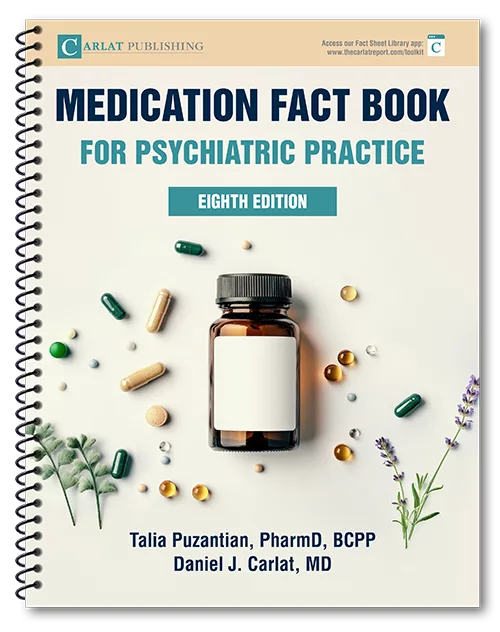Home » Lamictal: What is it Good For?
Lamictal: What is it Good For?
July 1, 2008
From The Carlat Psychiatry Report
Daniel Carlat, MD
Lamictal (lamotrigine) is immensely popular among American psychiatrists. A recent survey found that it is prescribed more frequently than any other mood stabilizer (Clin Psychiatry News, June 2008, page 1). Now that psychiatrists have become so comfortable with prescribing it, a disturbing question is gradually emerging from the fog of therapeutic enthusiasm. Is Lamictal actually effective?
True, it is approved by the FDA for bipolar disorder, but here is the precise wording, taken from the package insert: “Lamictal is indicated for the maintenance treatment of Bipolar I Disorder to delay the time to occurrence of mood episodes (depression, mania, hypomania, mixed episodes) in patients treated for acute mood episodes with standard therapy. The effectiveness of Lamictal in the acute treatment of mood episodes has not been established.”
In other words, the FDA is saying that Lamictal is effective only when prescribed to patients who are already euthymic — neither depressed nor manic. We’ve known for some time that the drug does not outperform placebo in quelling the symptoms of mania, although it is extremely hard to find the details of these studies. Most references to the data cite a poster presentation from a meeting (Bowden et al., 39th Annual ACNP Meeting, 2000).
In February of this year, we interviewed Nassir Ghaemi about the unpublished data showing that Lamictal is ineffective for the treatment of bipolar depression (TCPR Feb 2008, p. 4-5). Shortly thereafter, GSK finally published the negative Lamictal data they have been accumulating.
Let’s take a look at this new paper for what it might teach us about how Lamictal should or should not be used (Calabrese et al., Bipolar Disorders 2008;10:323-333). This is a review of the results of all five GSK-funded controlled trials of Lamictal for bipolar depression. According to another recent paper, these studies took place between 1996 and 2001 (Weisler et al., J Affect Disorders 2008;108:1-9).
The trials lasted from 7 to 10 weeks and all were placebo-controlled and double-blind. In total, they randomly assigned 607 patients to Lamictal, and 531 to placebo. The dose of Lamictal ranged from 50 mg/day to 400 mg/day, with the majority of patients gradually titrated to 200 mg/day. By and large, these patients had bipolar I disorder, and had moderate to severe depression on study entry. Exclusion criteria varied a bit, but all studies excluded rapid cyclers and those with prior Lamictal treatment. The primary outcome variable in two of the studies was the change in score from baseline to endpoint on the 17-item HAM-D (Hamilton depression scale), and for three of the studies was the change on the MADRS (Montgomery-Asberg Depression Rating Scale).
What were the results? There were no significant differences between Lamictal and placebo in any of the primary outcome variables for any of the five studies. In one study, however, some of the secondary outcome variables showed a significant benefit of Lamictal. The authors stress that patients in these studies demonstrated unusually high placebo response rates (from 35% to 48%, as estimated from bar graphs in the paper), and this may have led to the lack of separation between Lamictal and placebo. This is somewhat convincing. For example, the placebo response rates in the pivotal bipolar depression Seroquel trials were 36% to 37%, within range of the Lamictal placebo rates but certainly at the lower end of the scale (Calabrese, et al., Am J Psychiatry 2005).
So where does this leave us? According to the highest quality data, Lamictal is ineffective for the acute treatment of both manic and depressed episodes of bipolar disorder. The problem is that most clinicians will swear up and down that their depressed patients have, in fact, responded to Lamictal. Some of these responses must be placebo responses. However, consider an open label 16 week comparison of Lamictal and lithium. Researchers randomized patients with bipolar II depression to treatment with either Lamictal (N = 44, titrated to 200 mg/day) or lithium (N = 54, serum level 0.6-1.2 mEq/L) and followed them for 16 weeks (Suppes et al., J Affect Disord 2008, online version). This was a single-blind trial, in which only the raters were blinded to the treatment, and there was no placebo arm. Both treatments were effective: patients on Lamictal had a 67.5% response rate, and patients on Li, a 55.1% response rate (the difference was not statistically significant).
Why is this study important? Because one of the explanations offered for Lamictal’s generally poor performance in trials for depression is that its gradual titration requirement prevents it from achieving a therapeutic level within the time frame of short-term studies. This study, however, lasted 16 weeks, and while patients on Lamictal showed some improvement after 8 weeks, this improvement increased over the ensuing 8 weeks.
Thus, Lamictal may, indeed, be effective for bipolar depression, but only if continued for a long period of time. And this is likely why it performed better than placebo in the 18 month-long maintenance trials that led to FDA approval. True, it wasn’t shown to actually improve depression in these trials, just to delay it, but you might speculate that if the drug had been tested against placebo for 18 months for depression treatment, it might have shown an advantage.
So what’s the bottom line for this complicated but popular drug? If you decide to use it for acute depression, it may work, but don’t expect miracles quickly. Depending on where you stand on the issue of antidepressant safety in bipolar disorder, consider accompanying Lamictal with a quick burst of standard antidepressant treatment. Once the patient has stabilized, you can discontinue the antidepressant, leaving Lamictal on board to do its maintenance magic. If you are in the anti-antidepressant camp, then try Seroquel, now FDA-approved for bipolar depression. But the common side effects of this atypical antipsychotic — weight gain and sedation — continue to make it a less-than-attractive option.
TCPR Verdict:
Lamictal: Probably helps, but patience required
General PsychiatryTrue, it is approved by the FDA for bipolar disorder, but here is the precise wording, taken from the package insert: “Lamictal is indicated for the maintenance treatment of Bipolar I Disorder to delay the time to occurrence of mood episodes (depression, mania, hypomania, mixed episodes) in patients treated for acute mood episodes with standard therapy. The effectiveness of Lamictal in the acute treatment of mood episodes has not been established.”
In other words, the FDA is saying that Lamictal is effective only when prescribed to patients who are already euthymic — neither depressed nor manic. We’ve known for some time that the drug does not outperform placebo in quelling the symptoms of mania, although it is extremely hard to find the details of these studies. Most references to the data cite a poster presentation from a meeting (Bowden et al., 39th Annual ACNP Meeting, 2000).
In February of this year, we interviewed Nassir Ghaemi about the unpublished data showing that Lamictal is ineffective for the treatment of bipolar depression (TCPR Feb 2008, p. 4-5). Shortly thereafter, GSK finally published the negative Lamictal data they have been accumulating.
Let’s take a look at this new paper for what it might teach us about how Lamictal should or should not be used (Calabrese et al., Bipolar Disorders 2008;10:323-333). This is a review of the results of all five GSK-funded controlled trials of Lamictal for bipolar depression. According to another recent paper, these studies took place between 1996 and 2001 (Weisler et al., J Affect Disorders 2008;108:1-9).
The trials lasted from 7 to 10 weeks and all were placebo-controlled and double-blind. In total, they randomly assigned 607 patients to Lamictal, and 531 to placebo. The dose of Lamictal ranged from 50 mg/day to 400 mg/day, with the majority of patients gradually titrated to 200 mg/day. By and large, these patients had bipolar I disorder, and had moderate to severe depression on study entry. Exclusion criteria varied a bit, but all studies excluded rapid cyclers and those with prior Lamictal treatment. The primary outcome variable in two of the studies was the change in score from baseline to endpoint on the 17-item HAM-D (Hamilton depression scale), and for three of the studies was the change on the MADRS (Montgomery-Asberg Depression Rating Scale).
What were the results? There were no significant differences between Lamictal and placebo in any of the primary outcome variables for any of the five studies. In one study, however, some of the secondary outcome variables showed a significant benefit of Lamictal. The authors stress that patients in these studies demonstrated unusually high placebo response rates (from 35% to 48%, as estimated from bar graphs in the paper), and this may have led to the lack of separation between Lamictal and placebo. This is somewhat convincing. For example, the placebo response rates in the pivotal bipolar depression Seroquel trials were 36% to 37%, within range of the Lamictal placebo rates but certainly at the lower end of the scale (Calabrese, et al., Am J Psychiatry 2005).
So where does this leave us? According to the highest quality data, Lamictal is ineffective for the acute treatment of both manic and depressed episodes of bipolar disorder. The problem is that most clinicians will swear up and down that their depressed patients have, in fact, responded to Lamictal. Some of these responses must be placebo responses. However, consider an open label 16 week comparison of Lamictal and lithium. Researchers randomized patients with bipolar II depression to treatment with either Lamictal (N = 44, titrated to 200 mg/day) or lithium (N = 54, serum level 0.6-1.2 mEq/L) and followed them for 16 weeks (Suppes et al., J Affect Disord 2008, online version). This was a single-blind trial, in which only the raters were blinded to the treatment, and there was no placebo arm. Both treatments were effective: patients on Lamictal had a 67.5% response rate, and patients on Li, a 55.1% response rate (the difference was not statistically significant).
Why is this study important? Because one of the explanations offered for Lamictal’s generally poor performance in trials for depression is that its gradual titration requirement prevents it from achieving a therapeutic level within the time frame of short-term studies. This study, however, lasted 16 weeks, and while patients on Lamictal showed some improvement after 8 weeks, this improvement increased over the ensuing 8 weeks.
Thus, Lamictal may, indeed, be effective for bipolar depression, but only if continued for a long period of time. And this is likely why it performed better than placebo in the 18 month-long maintenance trials that led to FDA approval. True, it wasn’t shown to actually improve depression in these trials, just to delay it, but you might speculate that if the drug had been tested against placebo for 18 months for depression treatment, it might have shown an advantage.
So what’s the bottom line for this complicated but popular drug? If you decide to use it for acute depression, it may work, but don’t expect miracles quickly. Depending on where you stand on the issue of antidepressant safety in bipolar disorder, consider accompanying Lamictal with a quick burst of standard antidepressant treatment. Once the patient has stabilized, you can discontinue the antidepressant, leaving Lamictal on board to do its maintenance magic. If you are in the anti-antidepressant camp, then try Seroquel, now FDA-approved for bipolar depression. But the common side effects of this atypical antipsychotic — weight gain and sedation — continue to make it a less-than-attractive option.
TCPR Verdict:
Lamictal: Probably helps, but patience required
KEYWORDS mood_stabilizers
Issue Date: July 1, 2008
Table Of Contents
Recommended
Newsletters
Please see our Terms and Conditions, Privacy Policy, Subscription Agreement, Use of Cookies, and Hardware/Software Requirements to view our website.
© 2025 Carlat Publishing, LLC and Affiliates, All Rights Reserved.


_-The-Breakthrough-Antipsychotic-That-Could-Change-Everything.webp?t=1729528747)



